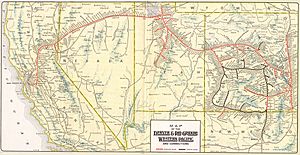Meadow Valley Wash facts for kids
Quick facts for kids Meadow Valley Wash |
|
|---|---|

The wash at the Union Pacific gate, north of Moapa
|
|
|
Location of the mouth of Meadow Valley Wash in Nevada
|
|
| Country | United States |
| State | Nevada |
| Region | Lower Colorado-Lake Mead subregion |
| Counties | Lincoln, Clark |
| Physical characteristics | |
| Main source | 38°11′29″N 114°11′15″W / 38.1913492°N 114.1874827°W |
| River mouth | Muddy River 36°39′50″N 114°34′19″W / 36.6638612°N 114.5719316°W |
| Basin features | |
| Basin size | 2,840 sq mi (7,400 km2) |
The Meadow Valley Wash is a stream in southern Nevada. It's called a "wash" because it's often dry. However, when there's a lot of rain, water flows through it! This wash helps drain water from a large area called the Meadow Watershed. This watershed is surrounded on three sides by the Great Basin Divide. This is like a big ridge that separates where water flows.
Contents
Where the Wash Flows
The Meadow Valley Wash starts in Lincoln County. Its starting point, or "headpoint," is high up in the Wilson Creek Range. As the wash flows, other smaller streams join it. One of these is the Patterson Wash.
Towns Along the Wash
The town of Panaca is located along the upper parts of the wash. Further downstream, past Caliente, another important stream joins the wash from the east.
Journey to the Muddy River
The wash continues its journey, eventually flowing from Lincoln County into the northeastern part of Clark County. It finally joins the Muddy River in the Moapa Valley. This meeting point is near Glendale, right next to Interstate 15. It's about 40 miles (64 km) northwest of the famous city of Las Vegas.
Surrounding Mountains
The land that drains into the Meadow Valley Wash is also bordered by other mountain ranges. To the west are the Delamar Mountains. To the east are the Meadow Valley Range.
History of the Wash
A long time ago, from 1903 to 1910, a railroad operated through the Meadow Valley Wash. This railroad was built by a businessman named William Andrews Clark. It connected the towns of Pioche and Panaca. However, the railroad was eventually damaged and washed away by big floods.



